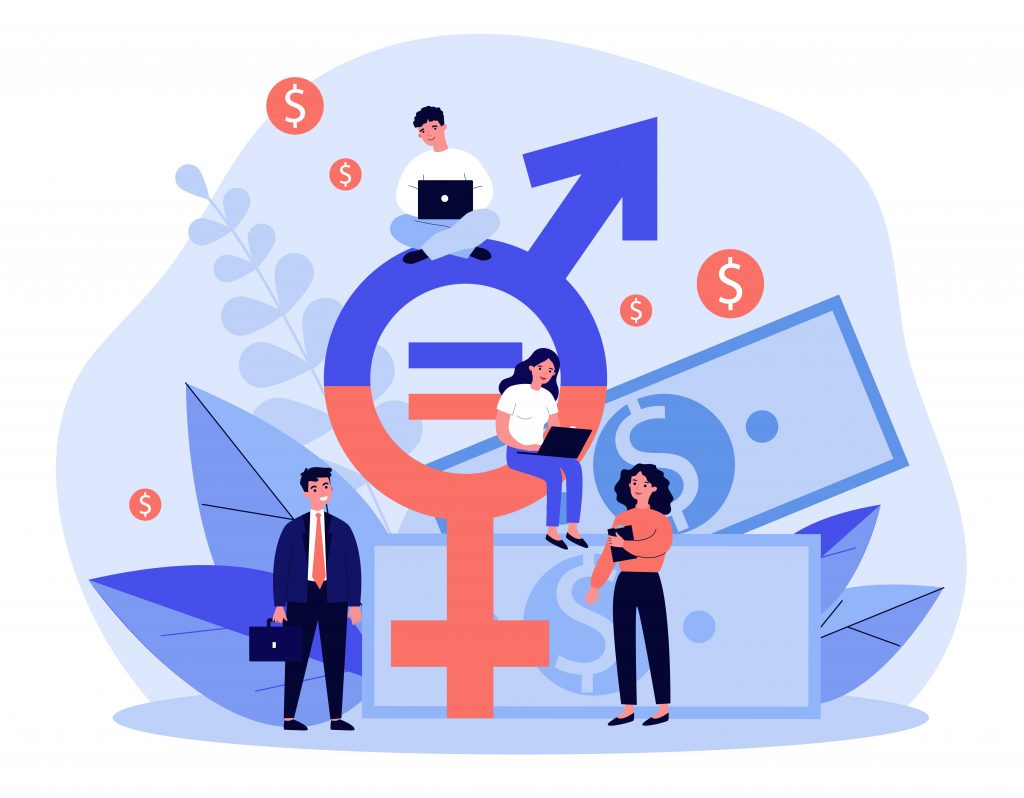By Emily Blobaum, Fearless editor

In the Business Record’s annual survey on women’s and gender issues, 63% of respondents stated that pay inequity in Iowa is a major issue.
Recent analysis from the Institute for Women’s Policy Research shows that racial and gender wage gaps are still deep. When looking at median weekly earnings, Hispanic women earn 59%, Black women earn 64%, white women earn 80% and Asian women earn 95% of white non-Hispanic men’s earnings. In Iowa, women on average earn 76 cents for every dollar a man earns.
When looking at historical data, back in 1950 the female-to-male median annual earnings ratio was 61%. In 2019, it was just over 82%. At the current rate, women won’t receive equal pay until 2062.
The gender wage gap and pay equity are large, complex issues that can’t be solved by a silver bullet. But experts agree that the best way to start addressing them is by talking about it and acknowledging that it exists.
We selected and emailed two dozen Iowa leaders who work in areas including higher education, nonprofit leadership, state government, employment law and business interest groups with a short survey about pay equity and salary transparency.
Six of them took the survey by the time of publication:
- Ann Brown, personal injury lawyer and employment law attorney at Ann Brown Legal in Cedar Rapids.
- Beth Livingston, assistant professor, faculty director of the Dore Emerging Women Leaders Program at the Tippie College of Business at University of Iowa.
- Rachel Bruns, deputy director of America’s Service Commissions, which is a nonprofit, nonpartisan organization representing and promoting state service commissions across the U.S.
- Kim Cheeks, executive officer at the Office on the Status of African-Americans and the Office on the Status of Women.
- Rep. Jennifer Konfrst, Iowa state representative, District 43, which includes areas of Windsor Heights, West Des Moines and Clive.
- Beatriz Mate-Kodjo, plaintiff’s employment attorney at Timmer Judkins in West Des Moines.
Responses have been lightly edited and condensed for clarity.
What is the best way to address pay inequity?
Mate-Kodjo: I think the first step in addressing pay inequity in Iowa is self-reflection and accountability, because the risk of unequal pay happens with or without ill intent. Some employers knowingly and proactively pay employees differently based on age, gender, race, etc. because of decision-maker biases and stereotypes about who is or is not qualified or “good” at any given job. Those choices open the door to unequal pay risk.
Livingston: This is a multifaceted issue that requires multifaceted solutions. Shedding sunlight on the magnitude of the problem and how it differs across industries and occupations and even within companies is the first step. Policies and guidelines regulating the sharing of salary and bonus information can help with this. Many times, employees do not know that they are being paid less for equal work. We should discuss this issue with nuance and a shared understanding that solving it requires public and private partnership and both individual and collective action. I think men should be encouraged to understand that this isn’t a “men vs. women” issue, but a “fair vs. unfair” issue.
Brown: The state of Iowa could require pay equity of private contractors and conduct audits like the federal government does. Iowa could enact paycheck transparency legislation, which would force employees to disclose to employees if they were being paid equally.
Bruns: Continue highlighting this issue and connecting it to how it’s harming businesses and the state’s ability to recruit and retain talent.
Cheeks: Identify causes and variables of the pay gap and find ways to resolve those root causes of the problem. Review compensation records and practices, and identify gaps. Collect data on certain work groups. Understand the difference between equal pay for equal work and the wage gap. Not providing equal pay for equal work to employees who do the same work is generally considered illegal discrimination. The gender wage gap, or pay gap, is a different concept that reflects the problems of unequal pay and a lack of other work-life support. Women earn less from the start, and the age range during which they earn the most is lower than it is for men.
Konfrst: Organizations should take a look at pay across the board and see if inequity exists. It probably does, so having that information helps ensure they’re starting from a place of facts. It’s important to do a thorough assessment of why. What assumptions have been used along the way to justify inequity, and how can those assumptions be challenged and remedied?
Would salary transparency policies help address pay inequity? Why or why not?
Brown: Yes. Women can’t take action if they don’t know they are being paid less than men who perform equal work.
Bruns: Yes. Research shows it works.
Cheeks: Yes. Transparency can attract and retain employees. Data can be used to determine practices and policies that are fair.
Livingston: Yes. Research has shown that pay transparency is useful for promoting equity and that employees do not react negatively to this information. It provides a check on manager actions and pay decisions, while also demonstrating trust in employees. For example, Lily Ledbetter did not know that she was paid less than her male counterparts because it was secret information. And some companies punish employees for talking about their pay (even though said punishment is illegal, according to the NLRB). But research has shown that pay transparency can actually improve employee motivation! When the process and outcomes around compensation are clearer, employees may actually perform better while simultaneously promoting equity and requiring companies to think through their compensation decision-making in more depth.
Konfrst: Yes. Information is key. When we’re honest with ourselves and our colleagues, and we are able to see where inequity exists, we can address it. And when employees can see what positions are paying across the board, they can also see where pay equity already exists, which could help avoid questions and false assumptions about salary.
Mate-Kodjo: Yes. Every employer is different and deserves a high level of freedom, ingenuity and choice. I am not a believer in micromanaging what entrepreneurs and business owners/leaders can and cannot do. That said, I will advocate for transparency because pay secrecy can create circumstances that catch an employer off-guard. Privacy and confidentiality should be respected, but it is important to remember that how an employer pays an employee is an objective measurement of how that employee is valued, for better or for worse. It is a risk to value employees for subjective or intrinsic reasons as opposed to objective metrics.
What are action steps that can be taken at the employer level to ensure pay equity?
Mate-Kodjo: There is no quick fix or easy solution to ensure pay equity. I believe the first action steps are self-reflection (e.g., an internal audit) and accountability (e.g., intra-departmental pay transparency). Those steps may lead to the need to create or implement remedies. Those are likely much easier for smaller organizations. We don’t hear enough about companies self-correcting, but it happens. That is honorable and should be celebrated. Most organizations do not mean to make discriminatory pay decisions, but if they find them or they are brought to their attention, doing the right thing is always an option. Corporate accountability does not make an organization weak or bad. Accountability is credibility; it shows the organization values the people that invest hours of their lives to advance the corporate mission.
Brown: Conduct internal audits by asking employees who they believe performs similar work to them in order to compare pay.
Livingston: Employer, know thyself. That’s my main suggestion. Analyze your data. See where the inequity exists. Recent research has also suggested that even among “equitable” firms, gender pay inequity can exist in benefits or stock options, so be thorough. Examine the policies through which pay is set in your company and be honest about the trade-offs. Finally, volunteer to publicize pay information where possible.
Bruns: Employers should always provide information on compensation, including the salary/wage or range, on job postings and descriptions. If they are open to negotiation, that can still be mentioned. Organizations that have job boards should strongly recommend or require salary transparency in order to post on their job board.
Konfrst: Audit salaries and positions across the board. Take a hard look at the “why” for the inequity, and examine hiring practices, job descriptions, requirements and interview strategies. Make salaries transparent.
Cheeks: Review applicable laws and practices surrounding fair labor standards, discrimination, civil rights. Train managers to communicate with employees about employment policies and compensation. Advocate to raise the minimum wage, to strengthen the economic security for families, and those where the woman is the sole breadwinner. The U.S. Department of Labor and the National Committee for Pay Equity have developed best practices and an Employer Self Assessment that can be useful in determining if your business has areas to improve. Have compensation and promotion policies and practices be as consistent and transparent as possible. Look at salary.com to benchmark your compensation with other businesses in the field and in your area. Calculate the percentage of male and female employees. Calculate the average female and average male monthly salary, including every full-time employee, including all levels of management. Divide the average female salary by the average male salary to determine your overall rate of equity.
Do actions need to be taken by the government to address pay equity? If so, what?
Konfrst: Yes. I think the government can expand things like the Ledbetter Pay Act and the Equal Pay Act to further incentivize organizations to pay fairly and avoid discrimination in pay. Additionally, requiring equal pay at all levels of government could address a segment of the working population and lead the way for others.
Brown: Yes. Congress needs to pass the Paycheck Fairness Act.
Bruns: Yes. Follow Colorado’s example and ban discrimination based on past salary and require salary transparency in job postings. The state should ensure all Iowans are making a livable wage. Businesses should pay their employees enough so they do not have to access state and federal resources such as Medicaid, SNAP and child care assistance. Taxpayers should not be subsidizing businesses in this way without some kind of waiver justifying how/why it is necessary. These changes would address the uncontrolled gender gap impacting women.
Livingston: Requiring audits can make companies invest in people with the skills to understand pay inequity at different levels within organizations. The government invested in O*Net and created one of the most useful job databases in the world. Government can do the same by investing in data gathering about pay across demographic groups and job levels. It can help students make job decisions, empower employees to change jobs, and improve equity. The one thing I’ll say, though, is that it could be used to target individuals and you have to balance privacy. But that’s not an absolute, it’s a “con” and so you have to determine how to balance those potentially competing values or come up with creative ways to address it. After all, public employees’ pay is publicly available already.
Cheeks: Yes. Support policies that make it a requirement for companies to share pay information. Support policies that improve the division of labor in the home. Support policies that provide access to good child care. Support policies that do not allow employers to base your current pay on your past pay.
Mate-Kodjo: Yes. Federal and state laws already prohibit unequal pay. Those laws are essential to ensuring parity in the workplace. Those laws exist to hold employers responsible when they choose to avoid or run from self-reflection and accountability. I think companies should be given leeway to make and enforce internal pay practices. However, I also think employees should advocate for themselves in court to enforce those laws. While a certain amount of grace and compassion for human error should be afforded employers, the sting of unequal pay and being valued as less-than for no objective reason is too strong to ignore. Employers that avoid or run from self-reflection and accountability will have to run a little faster to avoid the brave employees that stand up for equal rights and the lawyers that represent them, myself included.
Vermeer Chair Mary Andringa, representatives from Kum & Go and the Iowa division of the National Federation for Independent Business declined to take the survey.
Representatives from the Iowa Business Council, Sammons Financial Group, Iowa Association of Business and Industry, other lawmakers in the Iowa Legislature, Women Lead Change and Casey’s General Stores had not taken the survey by its deadline for publication.
The NFIB, which lobbied against legislation introduced this year that addressed pay equity in Iowa, responded with the following statement: “The specific issue of ‘pay equity’ does not show up in any of our data points or surveys that we conduct at NFIB. … NFIB has always opposed legislation where the government mandates/regulates who can work for a private small business, how much they have to pay an employee of a small business or how someone operates a private small business. Aside from high taxes, burdensome mandates or government regulations on small business are of grave concern to our members. One size fits all regulations tend to be job killers and quite frankly small business killers. HF 188 is a prime example of a one size fits all government regulation that would have a serious negative impact on the smallest of the small businesses in Iowa and that’s why we oppose that specific bill.”

